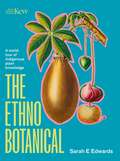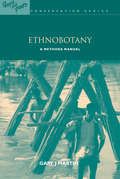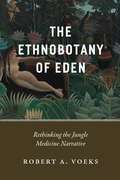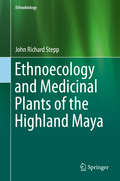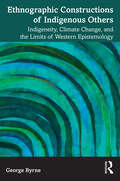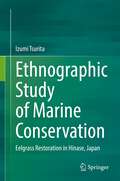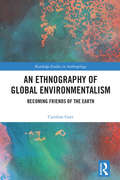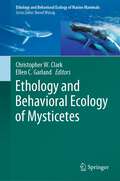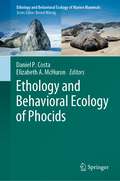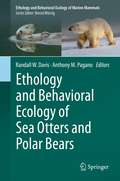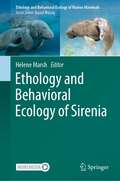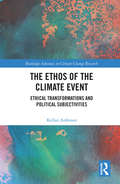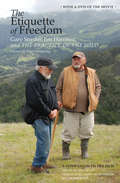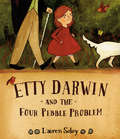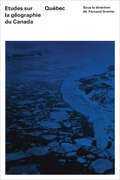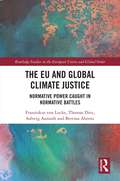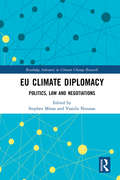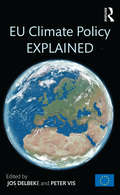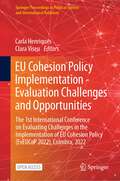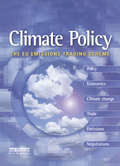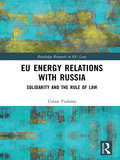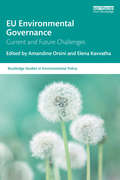- Table View
- List View
The Ethnobotanical: A world tour of Indigenous plant knowledge
by Dr Sarah EdwardsSince the beginning of humanity's existence, plants have provided us with everything we need for our survival - they sustain us with air to breathe, food to eat, materials to make clothes and shelter with, and medicine to treat and prevent disease. Their beauty can also enhance our mood and provide spiritual and emotional nourishment.Western science has 'discovered' and named innumerable plant species over the course of its colonial history. To many Indigenous peoples, however, plants have been recognised for centuries as sentient beings, imbued with spirit and agency to help humanity. Publishing in partnership with the Royal Botanic Gardens at Kew, The Ethnobotanical offers a unique and beautiful perspective on plants and their roles in the lives of peoples from across the planet.
Ethnobotany: A Methods Manual (People and Plants International Conservation)
by Gary J. MartinEthnobotany, the study of the classification, use and management of plants by people, draws on a range of disciplines, including natural and social sciences, to show how conservation of plants and of local knowledge about them can be achieved. Ethnobotany is critical to the growing importance of developing new crops and products such as drugs from traditional plants. This book is the basic introduction to the field, showing how botany, anthropology, ecology, economics and linguistics are all employed in the techniques and methods involved. It explains data collection and hypothesis testing and provides practical ideas on fieldwork ethics and the application of results to conservation and community development. Case studies illustrate the explanations, demonstrating the importance of collaboration in achieving results. Published with WWF, UNESCO and Royal Botanic Gardens Kew.
The Ethnobotany of Eden: Rethinking the Jungle Medicine Narrative
by Robert A. VoeksIn the mysterious and pristine forests of the tropics, a wealth of ethnobotanical panaceas and shamanic knowledge promises cures for everything from cancer and AIDS to the common cold. To access such miracles, we need only to discover and protect these medicinal treasures before they succumb to the corrosive forces of the modern world. A compelling biocultural story, certainly, and a popular perspective on the lands and peoples of equatorial latitudes—but true? Only in part. In The Ethnobotany of Eden, geographer Robert A. Voeks unravels the long lianas of history and occasional strands of truth that gave rise to this irresistible jungle medicine narrative. By exploring the interconnected worlds of anthropology, botany, and geography, Voeks shows that well-intentioned scientists and environmentalists originally crafted the jungle narrative with the primary goal of saving the world’s tropical rainforests from destruction. It was a strategy deployed to address a pressing environmental problem, one that appeared at a propitious point in history just as the Western world was taking a more globalized view of environmental issues. And yet, although supported by science and its practitioners, the story was also underpinned by a persuasive mix of myth, sentimentality, and nostalgia for a long-lost tropical Eden. Resurrecting the fascinating history of plant prospecting in the tropics, from the colonial era to the present day, The Ethnobotany of Eden rewrites with modern science the degradation narrative we’ve built up around tropical forests, revealing the entangled origins of our fables of forest cures.
Ethnoecology and Medicinal Plants of the Highland Maya (Ethnobiology Ser.)
by John Richard SteppPlants play a central role in human existence. Medicinal plants, in particular, have allowed for the continued survival of the human species. This book, based on over a decade of research in Southern Mexico with the Highland Maya, explores the relationship between medicinal plants, traditional ecological knowledge and the environment. The biodiversity of the region remains among the highest in the world, comprising more than 9000 plant species. Over 1600 employed for medicinal uses and knowledge for approximately 600 species is widespread. Medicinal plants play an overwhelmingly primary role in the daily health care of the Highland Maya. Three principal objectives are addressed: 1) identifying which medicinal plants are used; 2) determining the role of environmental variation on use and selection of medicinal plants; and 3) identifying which habitats are preferred for medicinal plant procurement. Findings demonstrate the overwhelming importance of human modified environments for medicinal plants. Explanations are presented from human ecology and biochemical ecology. Implications for conservation, health and the environment are discussed.
Ethnographic Constructions of Indigenous Others: Indigeneity, Climate Change, and the Limits of Western Epistemology
by George ByrneThis book examines the ways in which indigeneity interacts with climate change politics at multiple levels and at the same time offers a self-critical reflection on the role of ethnographic research (and researchers) in this process. Through a multi-sited ethnography, it shows how indigeneity and climate change mitigation are at this point so intensely intertwined that one cannot be clearly understood without considering the other. While indigenous identities have been (re)defined in relation to climate change, it argues that Indigenous Peoples continue to subvert pervasive notions of the nature/culture dichotomy and disrupt our understanding of what it means to be human in relation to nature. It encourages students and researchers in anthropology, international development, and other related fields to engage in more meaningful reflection on the epistemic shortcomings of “the West”, including in our own research, and to acknowledge the ongoing role of power, coloniality, extractivism, and whiteness in climate change discourses.
Ethnographic Study of Marine Conservation: Eelgrass Restoration in Hinase, Japan
by Izumi TsuritaThis book explores the nature of marine conservation based on the case study of Hinase, a fishing village in Okayama, Japan. It focuses on the fishers’ self-motivated eelgrass restoration activity which has been continued for more than 30 years. This activity in Hinase recently attracted international attention as a case under the name “Satoumi” and “Marine Protected Areas” in several governmental reports, but detailed information, such as the historical background and social structure of Hinase, has not yet been analyzed. This book, therefore, fulfills this gap by providing its ethnographic information. In addition, this book offers some points for critical thinking by concluding that marine conservation activities cannot always be evaluated or arranged under the standardized approach with limited time and space. This viewpoint reaffirms the importance of local initiative and highlights the value of qualitative research to seek the way forward for promising marine conservation. This book is suitable for an academic audience in the field of social sciences, such as applied anthropology, as well as ecologists, government officials, environmentalists, and citizens who are interested or engaged in environmental issues or natural resource management.
An Ethnography of Global Environmentalism: Becoming Friends of the Earth (Routledge Studies in Anthropology)
by Caroline GattBased on nine years of research, this is the first book to offer an in-depth ethnographic study of a transnational environmentalist federation and of activists themselves. The book presents an account of the daily life and the ethical strivings of environmental activist members of Friends of the Earth International (FoEI), exploring how a transnational federation is constituted and maintained, and how different people strive to work together in their hope of contributing to the creation of "a better future for the globe." In the context of FoEI, a great diversity of environmentalisms from around the world are negotiated, discussed and evolve in relation to the experiences of the different cultures, ecosystems and human situations that the activists bring with them to the federation. Key to the global scope of this project is the analysis of FoEI experiments in models for intercultural and inclusive decision-making. The provisional results of FoEI’s ongoing experiments in this area offer a glimpse of how different notions of the environment, and being an environmentalist, can come to work together without subsuming alterity.
Ethology and Behavioral Ecology of Mysticetes (Ethology and Behavioral Ecology of Marine Mammals)
by Christopher W. Clark Ellen C. GarlandIn this book, an international team of leading marine mammal scientists, with a remarkably diverse set of backgrounds and areas of expertise, lead you through a synthesis of current knowledge on baleen whales. Baleen whales are the largest animals ever to have lived on this planet. They also have the lowest and most intense voices on Earth, most likely evolved to take advantage of ocean acoustic transmission conditions so as to be detectable across ocean basins. Some baleen whales can live to be 150-200 years old. They migrate many thousands of kilometers between feeding and breeding areas. They produce songs and calls that serve as behavioral foundations for establishing, maintaining and expanding their cultural identities. To conclude that we know the behavioral limits of these large brained, long-lived animals would be naïve. As baleen whale scientists, we are still beginning to comprehend the enormous complexities and natural histories of these remarkable animals.Today, the fact that whales sing is known throughout much of the world. This awareness started 50 years ago with the publication and popularization of a collection of humpback song recordings that motivated research into baleen whale behavioral ethology. In this book’s chapters, a reader’s experiences will stretch from learning about baleen whale laryngeal anatomy associated with their different voices to learning about the vast ocean areas over which their voices can be heard and the emerging complexities of their culturally defined societies. These are accompanied by chapters on the fundamental ethological contexts of socializing, migrating, and foraging. Two common themes permeate the book. One theme highlights the phenomenal increase in scientific knowledge achieved through technological advancements. The other theme recognizes the impacts of human-made activities on ocean acoustic environments and the resultant influences on the health and survival of individual whales and their populations. Although the book is intentionally ambitious in its scope, as scientists, we fully recognize that baleen whale science is still in its infancy. Many profound revelations await discovery by cohorts of young, multi-talented explorers, some of whom are stretching their wings in this volume and some of whom are reading these scientific stories for the first time.
Ethology and Behavioral Ecology of Odontocetes (Ethology and Behavioral Ecology of Marine Mammals)
by Bernd WürsigThis book concentrates on the marine mammalian group of Odontocetes, the toothed whales, dolphins, and porpoises. In 23 chapters, a total of 40 authors describe general patterns of ethological concepts of odontocetes in their natural environments, with a strong bent towards behavioral ecology. Examples are given of particularly well-studied species and species groups for which enough data exist, especially from the past 15 years. The aim is to give a modern flavor of present knowledge of ethology and behavior of generally large-brained behaviorally flexible mammals that have evolved quite separately from social mammals on land. As well, the plight of populations and species due to humans is described in multiple chapters, with the goal that an understanding of behavior can help to solve or alleviate at least some human-made problems.
Ethology and Behavioral Ecology of Otariids and the Odobenid (Ethology and Behavioral Ecology of Marine Mammals)
by Claudio Campagna Robert HarcourtThis book is focused on the marine mammalian groups the Otariidae and the Odobenidae, otherwise known as fur seals, sea lions and the walrus. In 30 chapters, more than 60 authors from 30 institutions and 13 nationalities, discuss a broad suite of topics from maternal care and mating behavior, through play, cognition and personality, to adaptation to life in the Anthropocene. The authors explore the behaviors that have allowed these semi-aquatic mammals to thrive in the marine realm. Many populations have recovered following historical decimation, with interesting evolutionary consequences which are explored. Detailed, selected, individual species descriptions are also provided, showcasing the behavioral diversity of this engaging, adaptive and highly successful group of marine mammals.
Ethology and Behavioral Ecology of Phocids (Ethology and Behavioral Ecology of Marine Mammals)
by Daniel P. Costa Elizabeth A. McHuronPhocid (or earless or true) seals are ecologically diverse, occupying habitats from the tropics to the poles in marine and freshwater and feeding on anything from tiny zooplankton to other marine mammals. There are 18 species of phocid seals, the smallest species (ringed seal) is more than 20 times smaller than the largest (southern elephant seal), with marked sexual dimorphism present in some species. This book examines the behavior, ecology, and physiology that allow phocid seals to inhabit such a wide range of habitats. The book is composed of 16 chapters written by 37 authors from 8 countries. The book first describes the general patterns of phocid behavior, followed by descriptions of what is known about well-studied species. We have taken a holistic approach, focusing not only on the behaviors themselves but also on the factors that constrain the expression of behavior and the proximate mechanisms driving behavior. In many cases, the chapters represent collaborations between well-established researchers and early-mid career individuals who bring new perspectives to help carry the field of phocid behavioral ecology well into the future.
Ethology and Behavioral Ecology of Sea Otters and Polar Bears (Ethology and Behavioral Ecology of Marine Mammals)
by Randall W. Davis Anthony M. PaganoSea otters and polar bears are carnivorous marine mammals that still resemble their terrestrial ancestors. Compared with Cetacea (whales and dolphins), Sirenia (dugongs and manatees), and Pinnipedia (seals, sea lions, and walrus), they are less adapted for an aquatic life and the most recently evolved among marine mammals. Sea otters are amphibious but seldom come ashore, and polar bears primarily occur on sea ice or along the shore. When at sea, both species spend most of their time swimming at the surface or making short, shallow dives when foraging or pursuing prey. Indeed, polar bears rarely pursue seals in water. Nevertheless, polar bears are powerful swimmers and will stalk seals from the water. As with many other large carnivores, they are solitary hunters. Although sea otters are gregarious and form aggregations at sea called rafts, they are primarily asocial. Except during mating, the principal interaction among sea otters occurs between a female and offspring during the six-month dependency period. In large carnivores (e.g., wolves and lions) that feed on ungulates, sociality and cooperation are favored because of the need to capture large prey and defend carcasses. Polar bears, which are the largest terrestrial carnivore, are solitary hunters of seals and are neither gregarious nor social. Males and females briefly associate during courtship and mating. During this time, males aggressively compete for females. At other times, males generally avoid each other except for aggregations of males that form while summering on land, and females with cubs avoid males, which are known for infanticide. As with sea otters, the interaction of polar bears outside of mating occurs between a female and her offspring during the 2-3 year dependency period. This interaction is critically important when altricial cubs are born in the winter den. This book provides new insight into the ethology and behavioral ecology of sea otters and polar bears. Each chapter reviews the discoveries of previous studies and integrates recent research using new techniques and technology. The authors also address historic and current anthropogenic challenges for their survival as climate change alters entire marine ecosystems.
Ethology and Behavioral Ecology of Sirenia (Ethology and Behavioral Ecology of Marine Mammals)
by Helene MarshDespite their rich fossil history, there are only four surviving species of sirenians or sea cows, the only fully aquatic herbivorous mammals. The three species of manatees and the dugong live in the coastal waters rivers and lakes of more than 80 tropical and subtropical countries and are all on the IUCN Red List of Threatened Species. This book examines sirenian conservation biology through the lens of their behavioral ecology and ethology. Sirenian feeding, diving, movement, social and reproductive behaviors are reviewed by an international team of scientists from eight countries, with an emphasis on data gathered in the past 15 years.
The Ethos of the Climate Event: Ethical Transformations and Political Subjectivities (Routledge Advances in Climate Change Research)
by Kellan AnfinsonThis book develops a politico-ethical response to climate change that accounts for the novelty and uncertainty that it entails. This volume explores the ethical dimensions of climate change and posits that one must view it as a social construction intimately tied to political issues in order to understand and overcome this environmental challenge. To show how this ethos builds upon the need for new forms of responsiveness, Anfinson analyzes it in terms of four features: commitment, worldly sensitivity, political disposition, and practice. Each of these features is developed by putting four thinkers – Kierkegaard, Nietzsche, Schmitt, and Foucault respectively – in conversation with the literature on climate change. In doing so, this book shows how social habits and norms can be transformed through subjective thought and behavior in the context of a global environmental crisis. Presenting a multidisciplinary engagement with the politics, philosophy, and science of climate change, this book will be of great interest to students and scholars of climate change, environmental politics, environmental philosophy and environmental humanities.
Ethylene in Plants
by Chi-Kuang WenThis book focuses on recent advances in our understanding of the signal transduction pathway of ethylene, its interaction with other hormones and its roles in biological processes. It discusses at which point plants could have acquired ethylene signaling from an evolutionary perspective. Ethylene was the first gaseous hormone to be identified and triggers various responses in higher plants. Our grasp of ethylene signaling has rapidly expanded over the past two decades, due in part to the isolation of the components involved in the signal transduction pathway. The book offers a helpful guide for plant scientists and graduate students in related areas.
The Etiquette of Freedom: Gary Snyder, Jim Harrison, and The Practice of the Wild
by Jim Harrison Gary Snyder Paul EbenkampGary Snyder joined his old friend, novelist Jim Harrison, to discuss their loves and lives and what has become of them throughout the years. Set amidst the natural beauty of the Santa Lucia Mountains, their conversations-harnessing their ideas of all that is wild, sacred and intimate in this world-move from the admission that Snyder's mother was a devout atheist to his personal accounts of his initiation into Zen Buddhist culture, being literally dangled by the ankles over a cliff. After years of living in Japan, Snyder returns to the States to build a farmhouse in the remote foothills of the Sierras, a homestead he calls Kitkitdizze.For all of the depth in these conversations, Jim Harrison and Gary Snyder are humorous and friendly, and with the artfully interspersed dialogue from old friends and loves like Scott Slovic, Michael McClure, Jack Shoemaker, and Joanne Kyger, the discussion reaches a level of not only the personal, but the global, redefining our idea of the Beat Generation and challenging the future directions of the environmental movement and its association with "Deep Ecology."The Etiquette of Freedom is an all-encompassing companion to the film The Practice of the Wild. A DVD is included which contains the film together with more than an hour of out-takes and expanded interviews, as well as an extended reading by Gary Snyder. The whole offers a rare glimpse of their extended discussion of life and what it means to be wild and alive.
Etty Darwin and the Four Pebble Problem
by Lauren SoloyEtty Darwin and her famous father go for a walk to ponder life, science . . . and fairies! Inspired by the real-life daughter of Charles Darwin.Etty loves make-believe.Her dad loves science.Etty believes in fairies.Her dad would need to see some proof that they exist. But they both love nature, conversation and each other. A gorgeous rumination on belief and imagination featuring Henrietta (Etty) Darwin and her famous father, Charles. Etty went on to become a valued and keen editor of Charles's work and a thoughtful and intellectual being in her own right. This imagined conversation between Etty and Charles as they stroll around Charles's real-life "thinking track" explores their close relationship and shows that even science is nothing without an open mind and imagination.
Etudes sur la Geographie du Canada
by Fernand GrenierThe publication of the series, 'Studies in Canadian Geography,' by the organizers of the 22nd International Geographical Congress, introduces to the international community of geographers a new perspective of the regional entities which form this vast countries. These studies should contribute to a better understanding among scholars, students, and the people of Canada of the geography of their land. Geographical works embracing the whole of Canada, few in number until recently, have become more numerous during the last few years. This series is original in its purpose of re-evaluating the regional geography of Canada. In the hope of discovering the dynamic trends and the processes responsible for them, the editors and authors of these volumes have sought to interpret the main characteristics and unique attributes of the various regions, rather than follow a strictly inventorial approach. In preparing this volume on Quebec, the contributors have looked at the evolution and present patterns of the ecumene of southern Québec, rural and urban Québec, and the dynamic biogeography of Québec.
The EU and Global Climate Justice: Normative Power Caught in Normative Battles (Routledge Studies on the European Union and Global Order)
by Franziskus von Lucke Thomas Diez Solveig Aamodt Bettina AhrensThis book examines the European Union’s contribution to the development of the global climate regime within the broader framework of global justice. It argues that the procedural dimension of justice has been largely overlooked so far in the assessment of EU climate policy and reveals the EU has significantly contributed to the development of the climate regime within its broader efforts to ‘solidarise’ international society. At the same time, the book identifies deficits of the climate regime and limits to the EU’s impact and explains why the EU policy towards global climate change has shifted over time. Finally, however, it argues that these policies should not be assessed in terms of being either wholly positive or negative, but that they are shot through with ambiguities. This book will be of key interest to scholars, students and practitioners of climate change, climate politics, environmental and climate justice studies, and more broadly to EU Studies and International Relations.
EU Climate Diplomacy: Politics, Law and Negotiations (Routledge Advances in Climate Change Research)
by Stephen Minas and Vassilis NtousasThe European Union has long played a leadership role in the global response to climate change, including the development and dissemination of climate-friendly technologies such as renewable energy. EU diplomacy has been a vital contributor to the development of international cooperation on climate change through the agreement of the United Nations Climate Convention, its Kyoto Protocol and, most recently, the Paris Agreement. In addition, the election of Donald Trump as President of the United States means that the EU contribution to climate diplomacy will become more important still, both in filling the leadership gap (together with other major economies) and in responding to any sabotage by the Trump administration. This book will extend knowledge of the EU as a key actor in climate diplomacy by bringing together leading practitioners and researchers in this field to take stock of the EU’s current role and emerging issues. Contributions will be grouped into three strands: 1) the interplay between EU climate diplomacy and internal EU politics; 2) how the EU’s legal order is a factor that determines, enables and constrains its climate diplomacy; and 3) the EU’s contribution to diplomacy concerning climate technology both under the Climate Convention and more broadly. Collectively, these contributions will chart the EU’s role at a critical time of transition and uncertainty in the international response to climate change. EU Climate Diplomacy: Politics, Law and Negotiations will be of great relevance to students, scholars and policymakers with an interest in international climate politics and policy, transnational environmental law and politics and EU studies more generally.
EU Climate Policy Explained
by Jos Delbeke Peter VisThe EU has been the region of the world where the most climate policies have been implemented, and where practical policy experimentation in the field of the environment and climate change has been taking place at a rapid pace over the last twenty-five years. This has led to considerable success in reducing pollution, decoupling emissions from economic growth and fostering global technological leadership. <P><P>The objective of the book is to explain the EU's climate policies in an accessible way, to demonstrate the step-by-step approach that has been used to develop these policies, and the ways in which they have been tested and further improved in the light of experience. The book shows that there is no single policy instrument that can bring down greenhouse gas emissions, but the challenge has been to put a jigsaw of policy instruments together that is coherent, delivers emissions reductions, and is cost-effective. The book differs from existing books by the fact it covers the EU's emissions trading system, the energy sector and other economic sectors, including their development in the context of international climate policy. <P><P>Set against the backdrop of the 2015 UN Climate Change conference in Paris, this accessible book will be of great relevance to students, scholars and policy makers alike.
EU Cohesion Policy Implementation - Evaluation Challenges and Opportunities: The 1st International Conference on Evaluating Challenges in the Implementation of EU Cohesion Policy (EvEUCoP 2022), Coimbra, 2022 (Springer Proceedings in Political Science and International Relations)
by Carla Henriques Clara ViseuThis open access book is the result of the 1st International Conference on Evaluating Challenges in the Implementation of EU Cohesion Policy (EvEUCoP 2022). It presents the recent findings, sparks discussion, and reveals new research paths addressing the use of novel methodologies and approaches to tackle the challenges and opportunities that are unveiled with the implementation of the EU cohesion policy. The authors cover a wide range of topics including the monitoring of data; the clearness of indicators in measuring the impact of interventions; novel evaluation methods, addressing the mid-term and terminal assessment; as well as case studies and applications on evaluations of the thematic objectives under the scrutiny of the cohesion policy, namely:• Research, technological development, and innovation; • Information and communication technologies;• Shift toward a low-carbon economy.During the 2014-2020 programmatic period, member states were required to undertake assessments to evaluate the efficacy, efficiency, and impact of each operational program. Such evaluations are generally concerned with the compliance of projects and activities with programmatic priorities, as well as with funds' absorption capacity and refer to ex-ante and ex-post assessments. Hence, this book proposes the use of novel methodologies addressing the mid-term and terminal assessments that enable performing the efficiency appraisal of the operational programs and that can support decision-makers in the selection of projects that should be awarded for funding.
The EU Emissions Trading Scheme: Allocations, Incentives And Industrial Competitiveness Under The Eu Emissions Trading Scheme (Climate Policy Series)
by Sonja ButzengeigerThis special issue of the Climate Policy journal outlines the fundamentals of the new European Emissions Trading Scheme (EU ETS), assesses the strategies for and impact of implementation and highlights the scheme's potential, including positive aspects and remaining hurdles. The EU Emission Trading Scheme (EU ETS) is the first international trading scheme for CO2 in the world. Its aim is to reduce the cost of compliance to existing targets under the Kyoto Protocol. From 1st January 2005, companies in high-energy sectors covered by the scheme must limit their CO2 emissions to allocated levels, arranged in two periods: from 2005-2007 and 2008-2012 (to match the first Kyoto commitment period). In practice, the scheme is likely to cover over 12,000 installations across the European Union, corresponding to approximately 46% of the total EU CO2 emissions. The EU ETS represents a significant development in working at an international level to combat dangerous climate change. The EU Emissions Trading Scheme presents a comprehensive and insightful analysis of the EU ETS, written by international experts in the field. The publication includes the latest research on emissions credits, the interaction of the trading scheme with national energy policies and the debate on future expansion.
EU Energy Relations With Russia: Solidarity and the Rule of Law (Routledge Research in EU Law)
by Umut TurksenThis book provides a detailed analysis of the legal framework in which the energy trade between the European Union and the Russian Federation has been conducted. Using case studies of eight member states, it critically examines the EU’s ability and the duty of its Member States to conduct their external energy trade in accordance with the principle of solidarity. Providing a comprehensive analysis of the principle of solidarity as provided in the acquis communautaire of the EU, the book critically analyses the legal framework pertaining to EU-Russia energy trade to ascertain whether, and to what extent, it satisfies the requirements of the rule of law.
EU Environmental Governance: Current and Future Challenges (Routledge Studies in Environmental Policy)
by Amandine Orsini Elena KavvathaThis book presents an overview of the field of environmental law and policies within the European Union, from theoretical foundations to major issues and applied governance solutions. Drawing on expertise from renowned academics and practitioners from different disciplines, EU Environmental Governance: Current and Future Challenges helps readers to understand the main legal, political and economic issues of environmental protection since the adoption of the Paris Agreement by the European Union in 2015, until the 2020 Brexit, European Green Deal and coronavirus outbreak. The authors examine a broad range of sensitive and topical environmental issues including climate change, air pollution, waste management and circular economy, nuclear waste, biodiversity, agriculture, chemicals, nanotechnology, the environmental impacts of trade and environmental conflicts, presenting both current insights and future challenges. Overall, this volume exposes the reader to a vast array of empirical case studies, which will bolster their training and help tackle the environmental challenges faced by Europe today. This book is a valuable resource for students, researchers and policymakers across a broad range of fields, including environmental law and policies, environmental economics, climate science and environmental sociology.
